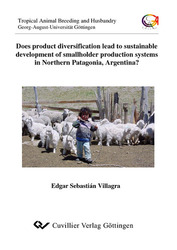| Fachbereiche | |
|---|---|
| Buchreihen (91) |
1271
|
| Geisteswissenschaften |
2263
|
| Naturwissenschaften |
5316
|
| Mathematik | 223 |
| Informatik | 311 |
| Physik | 972 |
| Chemie | 1348 |
| Geowissenschaften | 130 |
| Humanmedizin | 241 |
| Zahn-, Mund- und Kieferheilkunde | 10 |
| Veterinärmedizin | 99 |
| Pharmazie | 147 |
| Biologie | 812 |
| Biochemie, Molekularbiologie, Gentechnologie | 114 |
| Biophysik | 25 |
| Ernährungs- und Haushaltswissenschaften | 44 |
| Land- und Agrarwissenschaften | 993 |
| Forstwissenschaften | 202 |
| Gartenbauwissenschaft | 19 |
| Umweltforschung, Ökologie und Landespflege | 145 |
| Ingenieurwissenschaften |
1722
|
| Allgemein |
91
|
|
Leitlinien Unfallchirurgie
5. Auflage bestellen |
|
Erweiterte Suche
Does product diversification lead to sustainable development of smallholder production systems in Northern Patagonia, Argentina?
Edgar Sebastián Villagra (Autor)Vorschau
Inhaltsverzeichnis, Datei (7,3 KB)
Leseprobe, Datei (25 KB)
| ISBN-13 (Printausgabe) | 3865374980 |
| ISBN-13 (Printausgabe) | 9783865374981 |
| ISBN-13 (E-Book) | 9783736914988 |
| Sprache | Deutsch |
| Seitenanzahl | 138 |
| Auflage | 1 Aufl. |
| Erscheinungsort | Göttingen |
| Promotionsort | Göttingen |
| Erscheinungsdatum | 16.02.2005 |
| Allgemeine Einordnung | Dissertation |
| Fachbereiche |
Land- und Agrarwissenschaften
|
Beschreibung
In the arid and semi-arid plateaus of Northern Patagonia, Argentina, keeping Merino sheep for wool production is the most important rural activity for more than 5000 smallholders. Difficulties of wool commercialization, overgrazing, lower prices and higher costs of production, contributed to a decline in this activity and consequently in smallholders income. Promotion of diversification in sheep farms is seen as a promising development strategy.
The purpose of this study was to test if diversified farms lead to sustainable development of the smallholder livestock production systems. The field study was conducted between December 2002 and March 2004 in the south Region of Río Negro province, Northern Patagonia, Argentina. The data used were collected through a survey of 106 smallholder farm-households joining a development program (Livestock Program) owning only sheep flocks (sheep farms; n = 51) or mixed flocks:
sheep-goat (n = 25), sheep-cattle (n = 55) or sheep-goat-cattle (n = 10). Since the dimensions of sustainable development are ecological sustainability, economic feasibility and sociopolitical acceptability, the effects of diversification on the socio-economic and ecological performance of the systems were analyzed. The production and productivity of sheep keeping farms were calculated and compared with more diversified farms using a cost-benefit analysis. Effect of the different systems on the grassland condition was evaluated and compared. Finally, relationships between grassland productivity and animal production were evaluated. The data generated by the study were quantitative as well as qualitative, collected cross-sectionally and longitudinally.








